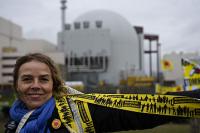Nearly 130,000 people are reported to have demonstrated across Europe against nuclear power on 11 March on the first anniversary of the Fukushima catastrophe. More demos are certain to have happened unreported.
At Gronau in Germany, site of a uranium enrichment plant that supplies fuel to a tenth of the world’s reactors, 4,000 people demonstrated, assisted by 25 farmers with their tractors.
The message to the globally operating German-Dutch-British corporation that owns the plant as well as to the German federal and state governments was that “The days of uranium enrichment in Gronau and Germany are numbered – anyone who wants to give up nuclear power cannot keep exporting uranium fuel to every tenth nuclear power station round the globe”.
Naho Dietrich-Nemoto from Fukushima-City reported movingly on the dramatic consequences for her homeland of the worst assumable accident. She called passionately for the activists to fight for the closure of all atomic installations.
There were several other demos in Germany. In Brokdorf 3,000 people surrounded a nuclear power station, at another, in Gundremmingen, it was 5,500, at a third, in Neckarwestheim, 5,000.
In Hannover 7,000 demonstrated for immediate closure of a nuke at Grohnde, while in the evening about 25,000 people formed a 75-kilometre-long human chain of lights between a planned final waste repository at Braunschweig and a dump drowning in brine at Salzgitter in northern Germany.
In the French Rhone Valley around 80,000 people formed a 230 km long chain between Lyon and Avignon – a impressive manifestation of liveliness in French nuclear resistance.

